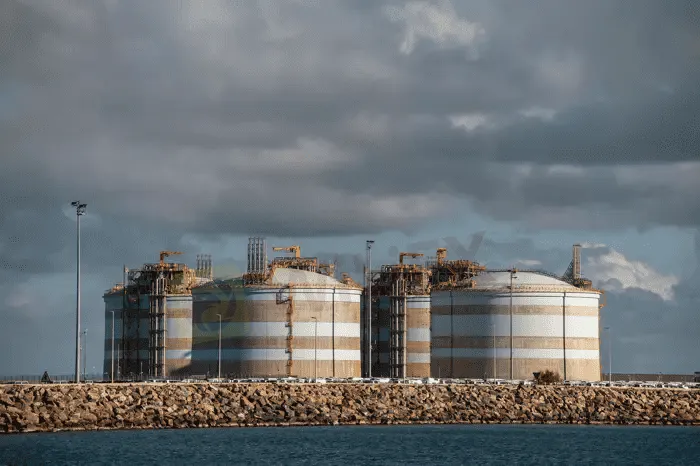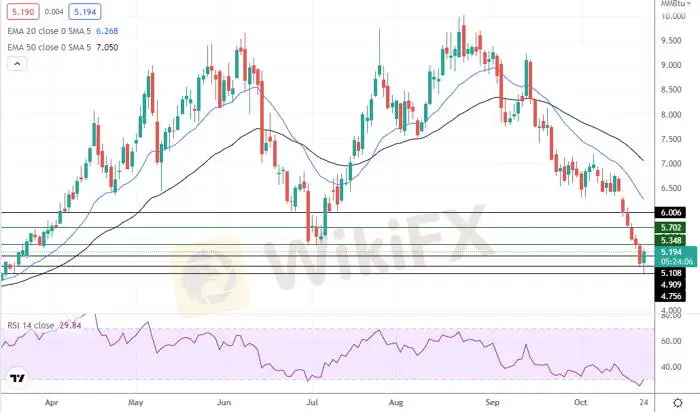简体中文
繁體中文
English
Pусский
日本語
ภาษาไทย
Tiếng Việt
Bahasa Indonesia
Español
हिन्दी
Filippiiniläinen
Français
Deutsch
Português
Türkçe
한국어
العربية
Natural Gas Moved Back Above The $5.00 Level
Abstract:WTI oil pulled back towards $84.50. Gold declined below the $1650 level.

Natural gas rebounded as traders took some profits off the table after the recent sell-off.
Precious metals declined as Treasury yields moved higher.
Copper pulled back after an unsuccessful attempt to settle above the $3.50 level.
Natural Gas Rebounds After Strong Sell-Off
Natural gas found support at $4.75 and moved above the resistance at $5.10 amid profit-taking after the major sell-off.
The weather forecast remains unfavorable for high natural gas consumption, but it has no impact on price dynamics today as natural gas markets were oversold.

The nearest significant resistance level for natural gas is located at $5.35. In case natural gas settles above this level, it will move towards the next resistance at $5.70. A successful test of this level will push natural gas towards the resistance at $6.00.
On the support side, natural gas needs to settle back below $5.10 to have a chance to gain downside momentum in the near term. The next support level for natural gas is located at $4.90. If natural gas declines below this level, it will move towards the support at the recent lows at $4.75.
WTI Oil Remains Volatile
WTI oil has recently made an attempt to settle above $85.50 but lost momentum and pulled back towards the $84.50 level as traders remained worried about the slowdown of the world economy.
Today‘s PMI reports highlighted the slowdown in developed economies. The data from China was more optimistic as the country’s third-quarter GDP grew 3.9% quarter-over-quarter, but the weak Retail Sales report showed that the economic situation remained challenging.
From a big picture point of view, WTI oil is trying to stabilize in the $83 – $86 range. In case this attempt is successful, WTI oil will have a decent chance to gain upside momentum if it manages to settle above the $86 level.
Gold Declines As Treasury Yields Move Higher
Gold declined below the $1650 level as the yield of 30-year Treasuries tested new highs. The yields of shorter-term Treasuries have also moved higher today despite disappointing PMI reports from the U.S.
Other precious metals have also found themselves under pressure. Silver made an attempt to settle above $19.50 but lost momentum and pulled back towards the $19.00 level. Platinum declined towards $930, while palladium moved towards the support level at $1965.
Copper Faced Strong Resistance Near $3.50
Copper moved back below the $3.45 level as traders focused on recession risks. Recession risks will remain the key negative catalyst for copper in the upcoming months as copper markets are extremely sensitive to changes in the economic outlook.
From a big picture point of view, copper is stuck in the wide range between the support at $3.25 and the resistance at $3.60. Most likely, copper will need significant catalysts to get out of this range.

Disclaimer:
The views in this article only represent the author's personal views, and do not constitute investment advice on this platform. This platform does not guarantee the accuracy, completeness and timeliness of the information in the article, and will not be liable for any loss caused by the use of or reliance on the information in the article.
Read more

Top 10 Trading Indicators Every Forex Trader Should Know
Master the top 10 Forex trading indicators to analyze real-time Forex quotes, trends, and market signals. Learn strategies to boost accuracy and avoid mistakes.

Geopolitical Events: What They Are & Their Impact?
You've heard many times that geopolitical events have a significant impact on the Forex market. But do you know what geopolitical events are and how they affect the FX market? Let us learn about it today.

Why Do You Feel Scared During Trade Execution?
Trade execution is a pivotal moment for traders. It is when analysis turns into action, and potential profits or losses become reality. However, for many traders, this moment is accompanied by fear. Why does this happen, and how can you address it?

Malaysian Influencer Detained in Taiwan Over Alleged Role in Fraud Scheme
Malaysian influencer Hu Chang Mun, widely known as Ady Hu, has been detained in Taiwan for his alleged involvement in a fraudulent operation. The 31-year-old, who was reported missing earlier in December, was located by Taiwanese authorities after suspicions arose regarding his activities.
WikiFX Broker
Latest News
Geopolitical Events: What They Are & Their Impact?
Volkswagen agrees deal to avoid Germany plant closures
Top 10 Trading Indicators Every Forex Trader Should Know
TradingView Launches Liquidity Analysis Tool DEX Screener
MultiBank Group Wins Big at Traders Fair Hong Kong 2024
WikiEXPO Global Expert Interview: Simone Martin—— Exploring Financial Regulation Change
'Young investors make investment decisions impulsively to keep up with current trends' FCA Reveals
Why Do You Feel Scared During Trade Execution?
CySEC Settles Compliance Case with Fxview Operator Charlgate Ltd
Scope Markets Review: Trustworthy or Risky?
Currency Calculator


